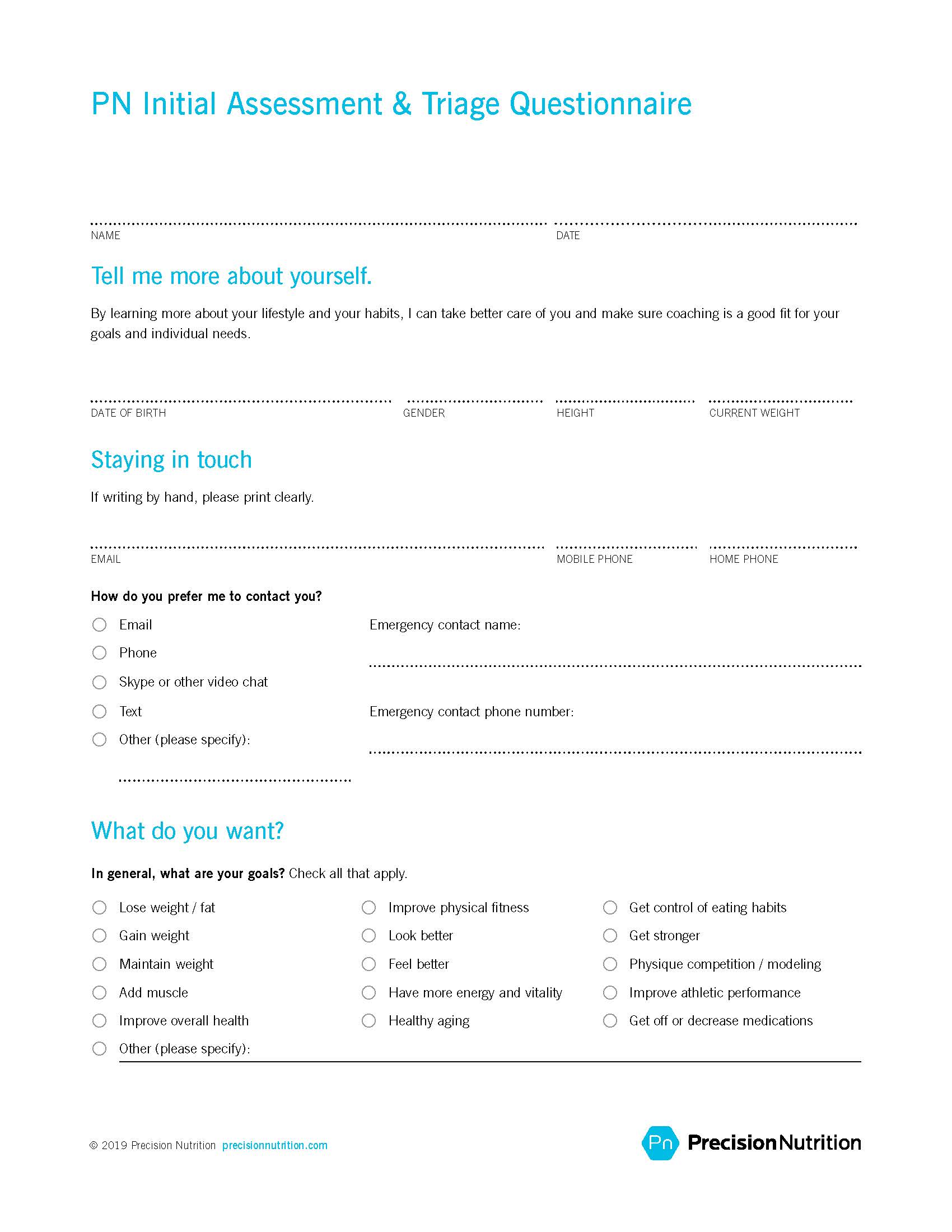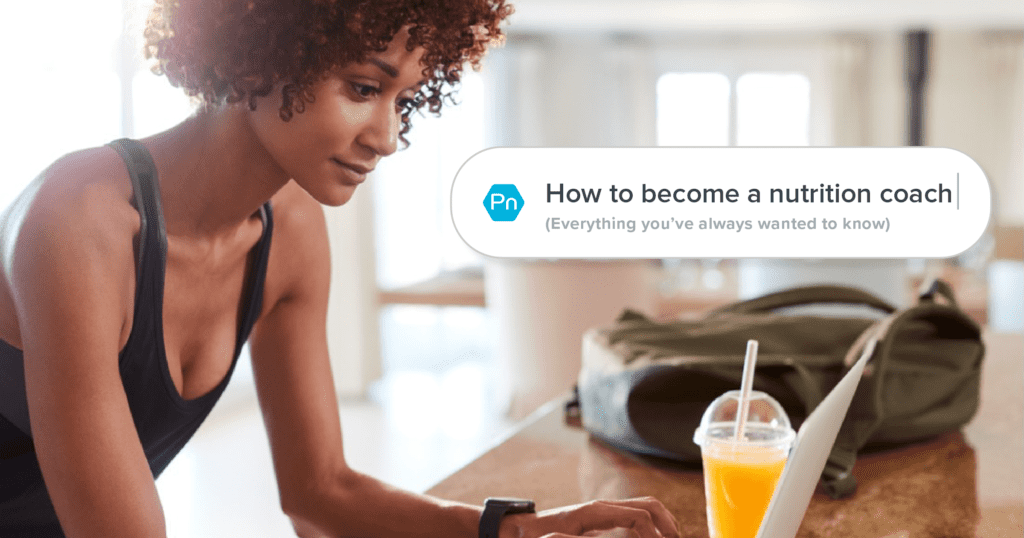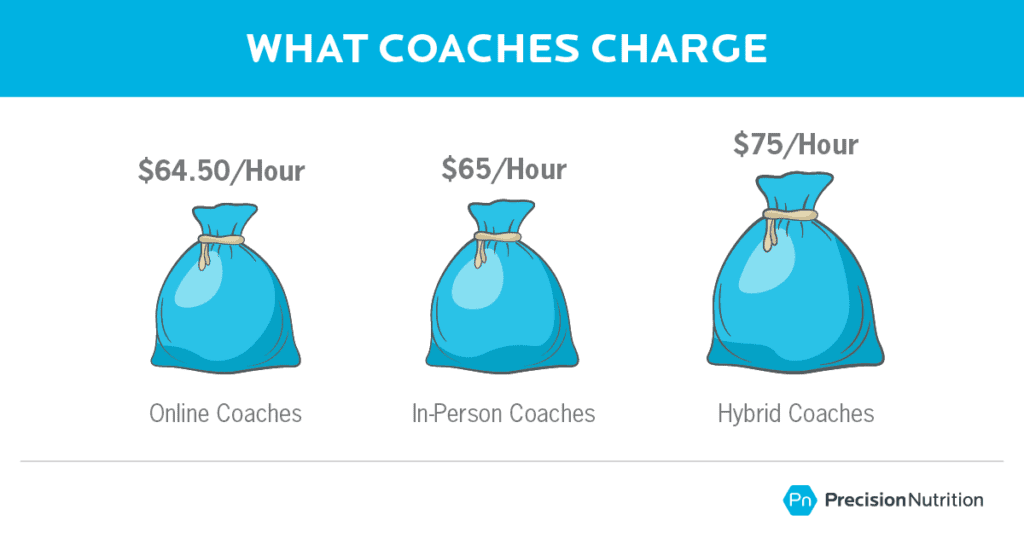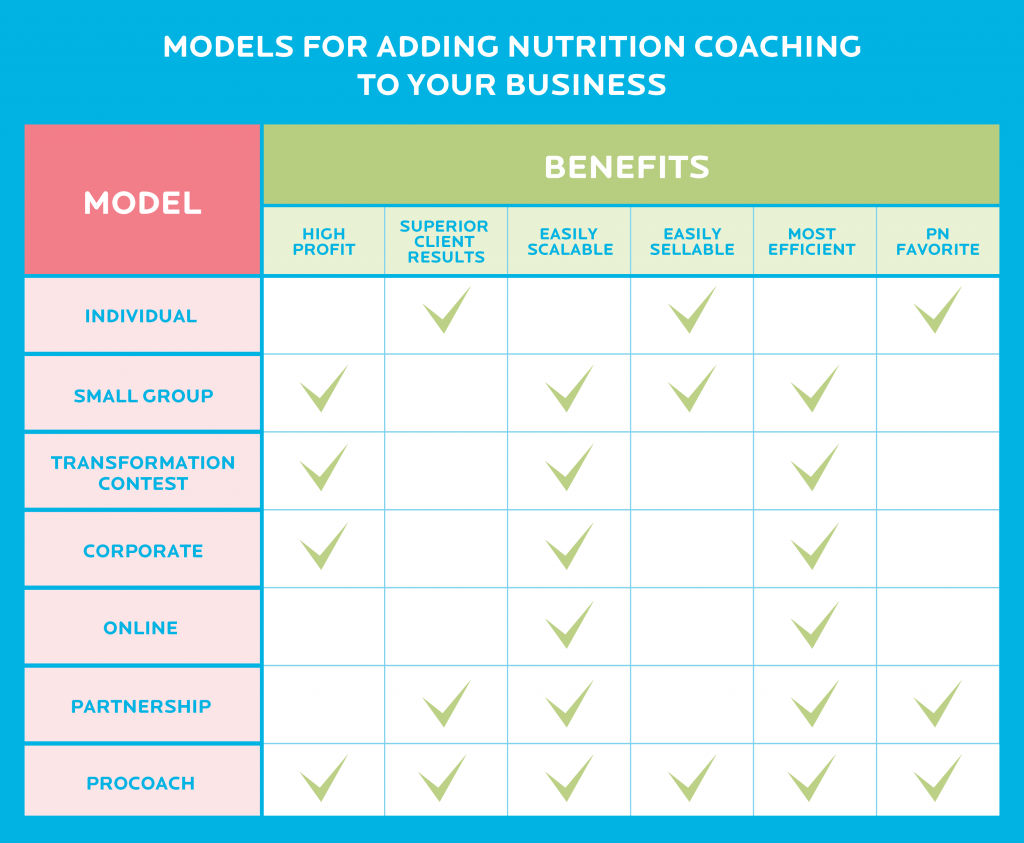Most successful nutrition, fitness, and health coaches will tell you…
Client intake forms are crucial.
That’s because, as the saying goes, “If you aren’t assessing, you’re guessing.”
And guessing about what your client wants and needs can leave both of you feeling frustrated.
For example, people who struggle with their weight are likely to overeat. But guessing at what’s causing them to overeat doesn’t usually work.
It could be their lack of sleep.
Or their stress levels.
Or their home environment.
It could even be a combination of all three.
Take Riley, who initially came to Precision Nutrition super coach Jeremy Fernandes, PN2, seeking weight loss.
After answering some stress-related questions on an intake form, Riley told Coach Jeremy:
“I knew my life was stressful, but I’ve never seen it in black and white. Wow.”
This new awareness gave Coach Jeremy an opportunity to identify—and start with—Riley’s most immediate coaching need.
For the first several weeks, Riley experimented with a variety of stress relief practices. In the end, those practices were the turnkey that allowed Riley to address nutrition and fitness.
And Coach Jeremy might not have known to start with stress reduction without doing a thorough client intake.
That’s why we devoted a whole story to the client intake process.
You’ll learn:
▶ How using a client intake form can make you a better coach.
▶ The questions you really need on a client intake form.
▶ Exactly how and when to use an intake form for the best results.
FREE Client Intake Form for health coaches!
Download and use our FREE fillable and printable client intake form. It’s the form we created for our Precision Nutrition Level 1 Certification students.
Use it as-is, or as a starting point to make your own.
Want to get it right now? Download it here.
++++
5 ways to use a client intake form to be a better health or nutrition coach
Aside from identifying immediate coaching needs, there are several ways a strategic coaching intake form and session can enhance your coaching practice. Here’s how.
#1: Highlight strengths you can build upon.
You’ll be able to see what clients are already doing well, and capitalize on that. Be sure to tell your clients what you notice they’ve already mastered.
#2: Identify limiting factors that might hold your clients back.
Let’s say a client tells you they want to get in the best shape of their life. But, through the intake, you see that they’re caring for an infant. They’re also going to night school. And working full-time. Clearly, their time is limited.
Unless you work together to find time for nutrition and exercise, it’s likely that the “best shape of their life” isn’t going to happen, no matter how brilliantly you design their programming.
#3: Get the conversational juices flowing.
You can use your clients’ intake questionnaire answers to find ways to connect. Get curious, ask questions, and form that coach-client bond.
#4: Smoothly segue into sensitive topics.
Imagine a client who thinks the key to losing weight is eating bananas. Just bananas. They’re frustrated because they’re not making progress.
When you look at their intake, you see that this person is only sleeping four hours at night.
You can now redirect the conversation without having to convince them their bananas-only approach won’t help them. Instead you can say something like:
“I noticed you’re not sleeping that much. How do you think that’s impacting your eating habits?”
#5: Overcome something called “the righting reflex.”
There’s a concept in motivational interviewing known as the righting reflex. (If you’ve done the Precision Nutrition Level 2 Certification, you may already know about it.)
The righting reflex is a coach’s tendency to jump in and steer their clients in a predetermined “right” direction.
But even if the right direction seems like a no-brainer (we all need more veggies, don’t we?), this sets up a dynamic where you argue for one thing (veggies!)—and your client digs in and argues against it (“I can’t eat more veggies because…”)
(It’s okay. We’ve all been there.)
A well-rounded intake helps you overcome this reflex by nudging you to ask follow up questions. By its very nature, the intake isn’t about prescribing and fixing. It’s about listening and learning.
(Want even more ways to become a better coach? Sign up for our FREE newsletter, The Smartest Coach in the Room: Every week you’ll get helpful takeaways on the hottest nutrition and health topics and the world’s most effective coaching techniques.)
Questions every intake form should have
Intake forms are about more than just stats, goals, and food. Ideally, they provide you with a well-rounded picture of your client’s health and life.
That’s why the best intake forms include questions about:
▶ Goals and desired outcomes: Does your client want better energy levels? Improved fitness? A different body composition?
▶ Current nutrition and lifestyle practices: What are their eating habits, food preferences, training habits, and sleep patterns?
▶ Nutrition and lifestyle knowledge: What have their past experiences with weight loss or gain been? How long have they been training?
▶ Body composition and measurements: What’s their current height and weight? What are their girth measurements?
▶ Social support and environment: Who do they live with? Who does the cooking in their house? How’s their support system?
▶ Health needs and limitations: Do they have any major health issues? Food allergies? Do they take medications?
▶ Function and physical capability: Do they have any pain? How’s their athletic performance?
▶ Psychological state and mindset: How ready are they to change? What are their emotions like right now?
Additionally, the intake form is a great place to capture communication preferences and style.
On this form, you can also add a medical disclaimer that requires clients to clear any new fitness or nutrition changes with their medical provider.
(For an extensive client intake template, see our FREE download above.)
Offer the intake form after your client has committed to coaching.
Many new nutrition, fitness, and health coaches ask: “Should I offer an intake session as a marketing tool? You know, a free service in order to seal the deal with a new client?”
Our take: Nope.
You really want to charge for the time you spend on this assessment.
That’s because the intake is an extensive process. It involves a lot of time for a client who may or may not commit.
So rather than give away a free intake, you might instead provide a free discovery call. Think of that call as a speed date. You’re using it to see whether you and the client are a good fit for one another.
Then have them complete the intake form after you’ve made the sale.
How to talk to clients about the intake form
It doesn’t have to be complicated. To broach the topic with new clients, you might say:
“I’m going to send you a detailed intake assessment because I want to get to know you. I want to learn more about your history, your goals, what you’ve done in the past. This will give me a 360-degree view of you.”
You might wonder: Is it better to do the intake together? Or give the client the intake form to fill out?
Usually, clients reveal more about themselves when they complete an intake form on their own.
Assigning it as “homework” gives them time to mull over questions. They might also be more honest about negative feelings like shame, anger, and guilt without having to make eye contact with you.
But this isn’t true of everyone. You’ll encounter clients who’re resistant to filling out the intake form. In that case, you might dedicate one of your first sessions to verbally going through the intake form together, almost like you’re interviewing them.
Or, you could devote 10-ish minutes of your first few sessions to diving into one or more aspects of the intake form, gradually building a relationship with your client over time.
What if a client doesn’t fill everything out?
That happens, and it’s okay.
You can say, “I noticed you didn’t answer this question on your intake form. Can you tell me more about that?”
Some clients will tell you that they’re overwhelmed. Or that the form included too many questions for them to process. In those cases, go over remaining questions in your next session and fill in the answers yourself.
Other clients might say, “I’m not ready to talk about that right now.” That may mean the questions triggered a trauma, stressor, or tension that they don’t yet feel safe enough to talk about.
In that case, back off, saying something like, “Okay, we can table that for now. Let’s focus on something else.”
What to do after your client gives you their intake form
You don’t have to act on all of the information at once. That would be overwhelming—for you and your client. So think of the intake form like a living document, one you expand on over time.
When your client sends you the form:
- Affirm that you received it, making sure to touch on one of their answers. For example, you might say, “I see you’ve tried a lot of diets in the past, and you want this one to be your last. I’m here to help. Let’s do this!”
- Set up time for a kick off meeting. This is when you go over the form, ask any questions you have, and start discussing how you’ll move forward.
- During the kick off meeting, review their responses. If needed, ask any follow up questions by saying, “Tell me more about…” or “I see you do shift work. How does that affect your sleep?”
- Make sure to mention positives. You might say, “Let’s build on your strengths. What do you feel you already have in place that might help you on this journey?”
You’ll also want to mention anything your client has shared that’s particularly sensitive or vulnerable. This applies even if the client’s revealed information that puts you miles outside your coaching lane.
For example, a client might tell you about their messy divorce or how they were molested as a child.
Unless you’re qualified as a mental health professional, you’re not here to help with these issues. At the same time, not acknowledging such a revelation could seem cold, or imply you’re uncomfortable talking about serious stuff.
To smoothly navigate back to your coaching lane, you might say, “I really appreciate that you were so honest and that you shared so openly with me.”
Then shift gears to your expertise, which is nutrition and health.
You might transition with something like, “So tell me, how is this showing up in your food behaviors today?”
(For more conversational ninja techniques for staying in scope, see: “I’m a Coach, Not a Therapist.”)
What to do after the kick off meeting
Once you’ve gone over your intake form and fully understand your client’s background, you’re ready to work together to set priorities. Use what you learned from the intake process to help your client define specific, clear, concrete goals that address their deepest motivations.
After all, you should know them pretty well by now.
If you’re a coach, or you want to be…
You can help people build sustainable nutrition and lifestyle habits that will significantly improve their physical and mental health—while you make a great living doing what you love. We'll show you how.
If you’d like to learn more, consider the PN Level 1 Nutrition Coaching Certification. (You can enroll now at a big discount.)







Share